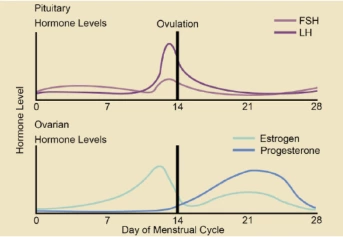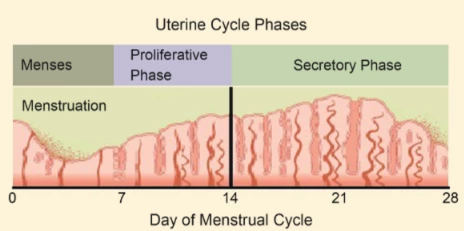Events Of Menstrual Cycle
Events of Menstrual Cycle
In this chapter, we will discuss various phases of the menstrual cycle. Between childhood and adulthood, there is a transition period in life, which is called adolescence. There are lots of physical and psychological changes that the body undergoes as part of the growth mechanism.
The sexual maturity in adolescents is commenced by puberty. During this period, a major role is played by the hormones. It is to be noted that there are differences in the boys and girls when it comes to the reproductive phase. So let us have a good study about the menstrual cycle, reproductive phase in detail to get the best idea about it.

Menstrual Phase 2. Follicular Phase 3. Ovulation Phase 4. Luteal Phase
Reproductive Phase: Menstrual Cycle
The onset of the reproductive phase in boys and girls is marked by adolescence. The beginning of this is the development of secondary sexual characteristics. The production of gametes in both males and females processes in different ways. The male and female are capable of reproducing once the gonads begin to produce gametes. It is during puberty that the reproductive phase begins in males and females. The reproductive phase lasts until death for males, but in the case of females, it ends at the age of 50 years.
It is the menstruation or menstrual cycle that marks the commencement of puberty in girls. From the age of 10 to 15, the reproductive phase emerges for girls when she attains puberty. The eggs in ovaries start to mature when puberty arrives. The mature ovum is released by one of the ovaries every 28 to 30 days. This phase is known as ovulation. The uterus prepares itself for implantation, which becomes thicker.
If the sperm gets fused by the egg, it becomes fertilized, which in turn leads to pregnancy. On the other hand, shedding or uterus walls are experienced by the females by the unfertilized egg, which causes bleeding in women. This phase that leads to bleeding is called menstruation. It is at the age of 50 that the menstrual cycle stops forever, which is termed as menopause. It should be noted that it is the hormonal imbalance that causes irregularity in the menstrual cycle.
Phases or Events of the Menstrual Cycle
First of all, we need to understand about the ovarian cycle. Well, it is the events of the menstrual cycle that takes place in the ovaries. There are three phases of the ovarian cycle which are the follicular phase, ovulation, and luteal phase. You can have a look at the figure below:
Follicular Phase
The first phase of the ovarian cycle is the ovarian cycle. The duration of this phase is about 12 to 14 days. Several ovarian follicles get stimulated during this phase which begins maturing. But here, the Graafian follicle is the only one that matures completely to make it ready to release an egg. The other maturing follicles disintegrate. The follicular development occurs due to a rise in the blood level of follicle-stimulating hormone (FSH ).
Here, the pituitary gland secretes the follicle-stimulating hormone. Estrogen is released by the maturing follicle which leads to the rise of the level throughout the follicular phase. Look at the below chart to see other changes in hormone levels that occur during the menstrual cycle.

Ovulation
The second phase of the ovarian cycle is ovulation. It is around day 14 of the menstrual cycle that this occurs. The Graafian follicle ruptures during this phase where the egg is released. It is from the pituitary gland that is stimulated by a sudden rise in the blood level of luteinizing hormone. This is known as the LH surge, where you can look at the above graph. It starts around day 12 of the cycle where it lasts for a day or even two as well.
Related Videos:
- What is menstrual cycle? Name the hormones that regulate menstrual cycle?
- Reproduction
- Sexual Reproduction
- Asexual reproduction?
- Different phases of menstrual cycle
Luteal Phase
The luteal phase is the third and final phase of the ovarian cycle is the luteal phase. It is seen to lasts about 14 days in a 28-day menstrual cycle. At the beginning of the luteal phase, the Graafian follicle is caused by the FSH and LH that ovulated the egg to transform into a structure called a corpus luteum.
Uterine Cycle
The uterine cycle takes place in the uterus. It leads to the occurrence of changes, mainly in the endometrium. There are three phases of the uterine cycle which are menstruation, proliferative phase, and secretory phase. The below figure illustrates the three phases of the uterine cycle.

- Menstruation: It is also known as the menstrual period or menses. Well, in the uterine cycle, this is the first phase. It should be mentioned that the average blood loss during menstruation is about 35ml. There are also uterine cramps that occur which may be severe to some women.
- Proliferative Phase: The second phase of the uterine cycle is the proliferative phase. Here, in this phase, the cells of the maturing ovarian follicle secreted estrogen that leads to the lining of the uterus to grow.
- Secretory Phase: The third and final phase of the uterine cycle is the secretory phase. During this phase, the corpus luteum produces progesterone in the ovary. For example, the flow of blood to the uterus is increased by the progesterone that helps in promoting uterine secretions. The contractility of smooth muscles tissue is also decreased in the uterine wall.
Important Chapters:



Similar Questions
Knowledge Check
- Question 1 - Select One
All the events of the menstrual cycle stop and there is no menstruation during pregnancy is due to
ANegative feedback of FSH & LHBNegative feedback of oxytocinCNegative feedback of prolactinDNegative feedback of progesterone - Question 2 - Select One
Menstrual cycle occur in
AFemale primatesBHuman females onlyCMammalian females other than primatesDRabbit only. - Question 3 - Select One
Arrange the events in human female menstrual cycle
a-Secretion of FSH, b-Growth of corpus luteum,
c-Growth of follicle and oogenesis, d-Ovulation,
e-Sudden increase in level of LHAa−c−e−d−bBc−a−d−b−eCa−d−c−e−bDb−a−c−d−e
What is menstrual cycle? Name the four phases of menstrual cycle. Mention the hormones involved in the control of menstrual cycle in human female
View SolutionWhat is menstrual cycle? Explain the various phases of menstrual cycle.
View SolutionWhat is menstrual cycle ? Name any two stages of menstrual cycle.
View SolutionWhat are the different phases of menstrual cycle?
View SolutionDefine menstrual cycle.
View Solution

